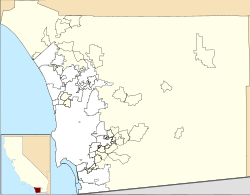St. Matthew's Episcopal Church | |
 | |
| Location | 521 E. 8th St., National City, California |
|---|---|
| Coordinates | 32°40′40″N117°6′2″W / 32.67778°N 117.10056°W |
| Area | 0.4 acres (0.16 ha) |
| Built | 1887 |
| Architect | William Herman |
| Architectural style | Gothic Revival |
| NRHP reference No. | 73000432 [1] |
| Added to NRHP | October 25, 1973 |
St. Matthew's Episcopal Church is a historic church at 521 E. 8th Street in National City, California. It was built in 1887. It is an active congregation within the Episcopal Church and is part of the Diocese of San Diego.[ citation needed ]



